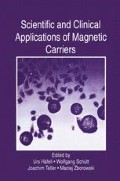Abstract
The method presented in this article for the mechanical stimulation of cells via specific receptors was adapted from the method of Wang and Ingber.1,2 Unlike most current methods which apply strain to the cell as a whole, our method is able to determine the specific receptors involved in stress transduction. The stress is applied using ferromagnetic microbeads coated with receptor-specific ligands. After adhesion to cells, the beads are magnetized and then “twisted” using a magnetic field oriented perpendicular to the magnetizing field. This method was applied to osteoblastic cells, and it could be shown that mechanical stress on integrin receptors induces specific tyrosine phosphorylation.
Access this chapter
Tax calculation will be finalised at checkout
Purchases are for personal use only
Preview
Unable to display preview. Download preview PDF.
References
Wang N, Butler JP, Ingber DE (1993). Mechanotransduction across the cell surface and through the cytoskeleton.Science 260, 1124–1127.
Wang N, Ingber DE (1995). Probing transmembrane mechanical coupling and cytomechanics using magnetic twisting cytometry.Biochemical Cell Biology 73, 327–335.
Davies PF, Tripathi SC (1993). Mechanical stress mechanisms and the cell.Circulation Research 72, 239–245.
Jones D, Leivseth G, Tenbosch J (1995). Mechano-reception in osteoblast-like cells.Biochemical Cell Biology 73, 525–534.
James NL, Harrison DG, Nerem RM (1995). Effects of shear on endothelial cell calcium in the presence and absence of ATP.FASEB Journal 9, 968–973.
Basdra EK, Huber LA, Komposch G, Papavassiliou AG (1994). Mechanical loading triggers specific biochemical responses in mandibular chondrocytes.Biochimica et Biophysica Acta 1222, 315–322.
Hamasaki K, Nojima Y et al (1995). Stretching mesangial cells stimulates tyrosine phosphorylation of focal adhesion kinase pp125FAK.Biochemical and Biophysical Research Communications 212, 544–549.
Reich KM, Gay CV, Frangos JA (1990). Fluid shear stress as a mediator of osteoblast cyclic adenosine monophosphate production.Journal of Cellular Physiology 143, 100–104.
Lambert CA, Soudant EP, Nusgens BV, Lapiere CM (1992). Pretranslational regulation of extracellular matrix macromolecules and collagenase expression in fibroblasts by mechanical force.Laboratory Investigation 66, 444–451.
Holmvall K, Camper L, Johnasson S, Kimura JH, Lundgren-Akerlund E (1995). Chondrocyte and chondrosarcoma cell ‘ntegrins with affinity for collagen type II and their response to mechanical stress.Experimental Cell Research 221, 496–503.
Buckley MJ, Banes AJ, Jordan RD (1990). The effects of mechanical strain on osteoblasts in vitro.Journal of Maxillofacial Surgery 48, 276–282.
Barbee K (1995). Changes in surface topography in endothelial monolayers with time at confluence: influence on subcellular shear stress distribution due to flow.Biochemical Cell Biology 73, 501–505.
Kimmel DB (1993). A paradigm for skeletal strength homeostasis.Journal of Bone and Mineral Research 8, Suppl. 2, S515 - S522.
Ruoslahti E (1991). Integrins.Journal of Cinical Investigation 87, 1–5.
Albelda SM, Buck CA (1990). Integrins and other cell adhesion molecules.FASEB Journal 4, 2868–2880.
Hynes RO (1992). Integrins: Versatility, modulation and signaling in cell adhesion.Cell 69, 11–25.
Giancotti FG, Mainiero F (1994). Integrin-mediated adhesion and signaling in tumorgenesis.Biochimica et Biophysica Acta 1198, 47–64.
Yamada KM, Miyamoto S (1995). Integrin transmembrane signaling and cytoskeletal control.Current Opinions in Cell Biology 7, 681–689.
Clark EA, Brugge JS (1995). Integrins and signal transduction pathways: the road taken.Science 268, 233–239.
Juliano RL, Haskill S (1993). Signal transduction from the extracellular matrix.Journal of Cell Biology 120, 577–585.
Prasad ARS, Logan SA, Nerem RM, Schwartr CJ, Sprague EA (1993). Flow-related response of intracellular inositol phosphate levels in cultured aortic endothelial cells.Circulation Research 72, 827–836.
Klein-Nulend J, van der Plas A, Semeins CM, Ajubi NE, Frangos JA, Nijweide PJ, Burger EH (1995). Sensitivity of osteocytes to biomechanical stress in vitro.FASEB Journal 9, 441–445.
Carvalho RS, Scott JE, Suga DM, Yen EHK (1994). Stimulation of signal transduction pathways in osteoblasts by mechanical strain potentiated by parathyroid hormone.Journal of Bone and Mineral Research 7, 999–1011.
Kollros PR, Bates SR, Mathews MB, Horwitz AL, Glagov S (1987). Cyclic AMP inhibits increased collagen production by cyclically stretched smooth muscle cells.Laboratory Investigation 56, 410–417.
Schwartz MA, Cragoe EJ, Lechene CP (1990). pH regulation in spread cells and round cells.Journal of Biological Chemistry 265, 1327–1332.
Schwartz MA, Lechene C, Ingber DE (1991). Insoluble fibronectin activates the Na/H antiporter by clustering and immobilizing integrin α5β1, independent of cell shape.Proc. Nat. Acad. Sci. USA 88, 7849–7853.
Banes AJ, Tsuzaki M, Yamamoto J, Fischer T, Brigman B, Brown T, Miller L (1995). Mechanoreception at the cellular level: the detection, interpretation, and diversity of responses to mechanical signals.Biochemical Cell Biology 73, 349–365.
Wallace LM, Ham RG (1976). Stimulation of clonal growth of normal fibroblasts with substrata coated with basic polymers.Journal of Cell Biology 71, 727–734.
Author information
Authors and Affiliations
Editor information
Editors and Affiliations
Rights and permissions
Copyright information
© 1997 Springer Science+Business Media New York
About this chapter
Cite this chapter
Bierbaum, S., Notbohm, H. (1997). Magnetomechanical Stimulation of Mesenchymal Cells. In: Häfeli, U., Schütt, W., Teller, J., Zborowski, M. (eds) Scientific and Clinical Applications of Magnetic Carriers. Springer, Boston, MA. https://doi.org/10.1007/978-1-4757-6482-6_23
Download citation
DOI: https://doi.org/10.1007/978-1-4757-6482-6_23
Publisher Name: Springer, Boston, MA
Print ISBN: 978-1-4419-3283-9
Online ISBN: 978-1-4757-6482-6
eBook Packages: Springer Book Archive

